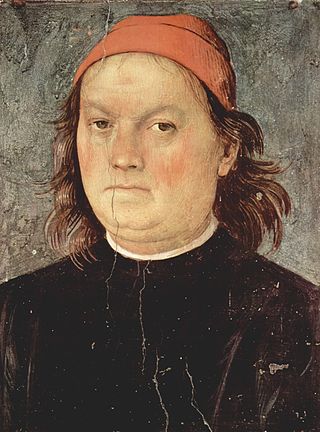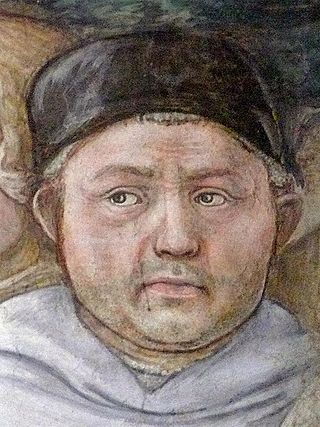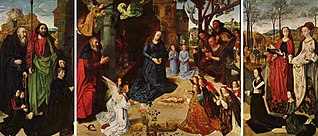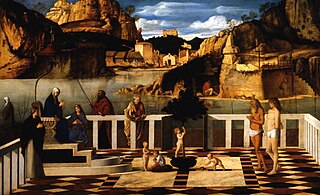
Filippino Lippi was an Italian Renaissance painter mostly working in Florence, Italy during the later years of the Early Renaissance and first few years of the High Renaissance. He also worked in Rome for a period from 1488, and later in the Milan area and Bologna.

Luca Signorelli was an Italian Renaissance painter from Cortona, in Tuscany, who was noted in particular for his ability as a draftsman and his use of foreshortening. His massive frescos of the Last Judgment (1499–1503) in Orvieto Cathedral are considered his masterpiece.

The Pietà is a subject in Christian art depicting the Blessed Virgin Mary cradling the mortal body of Jesus Christ after his Descent from the Cross. It is most often found in sculpture. The Pietà is a specific form of the Lamentation of Christ in which Jesus is mourned by the Virgin Mary alone. However, in practice works called a Pietà may include angels, the other figures usual in Lamentations, and even donor portraits.

The Adoration of the Magi or Adoration of the Kings or Visitation of the Wise Men is the name traditionally given to the subject in the Nativity of Jesus in art in which the three Magi, represented as kings, especially in the West, having found Jesus by following a star, lay before him gifts of gold, frankincense, and myrrh, and worship him. It is related in the Bible by Matthew 2:11: "On entering the house, they saw the child with Mary his mother; and they knelt down and paid him homage. Then, opening their treasure chests, they offered him gifts of gold, frankincense, and myrrh. And having been warned in a dream not to return to Herod, they left for their own country by another path".

Pietro Perugino, an Italian Renaissance painter of the Umbrian school, developed some of the qualities that found classic expression in the High Renaissance. Raphael became his most famous pupil.

Filippo Lippi, also known as Lippo Lippi, was an Italian Renaissance painter of the Quattrocento and a Carmelite priest. He was an early Renaissance master of a painting workshop, who taught many painters. Sandro Botticelli and Francesco di Pesello were among his most distinguished pupils. His son, Filippino Lippi, also studied under him and assisted in some late works.

Francesco Francia, whose real name was Francesco Raibolini was an Italian painter, goldsmith, and medallist from Bologna, who was also director of the city mint.

Hugo van der Goes was one of the most significant and original Early Netherlandish painters of the late 15th century. Van der Goes was an important painter of altarpieces as well as portraits. He introduced important innovations in painting through his monumental style, use of a specific colour range and individualistic manner of portraiture. From 1483 onwards, the presence of his masterpiece, the Portinari Triptych, in Florence played a role in the development of realism and the use of colour in Italian Renaissance art.

The Portinari Altarpiece or Portinari Triptych is an oil-on-wood triptych painting by the Flemish painter Hugo van der Goes, commissioned by Tommaso Portinari, representing the Adoration of the Shepherds. It measures 253 x 304 cm, and is now in the Galleria degli Uffizi in Florence, Italy. This altarpiece is filled with figures and religious symbols. Of all the late-fifteenth-century Flemish artworks, this painting is said to be the most studied.

The Adoration of the Shepherds is the traditional name for a New Testament episode in the story of Jesus's nativity, which is the subject of many works of art. In it shepherds are near witnesses to Jesus's birth in Bethlehem, arriving soon after he is actually born. The episode is recounted, or at least implied, in the Gospel of Luke and follows on from the annunciation to the shepherds, in which the shepherds are summoned by an angel to the scene of the birth. Like the episode preceding it, the adoration is a common subject in art, where it is often combined with the Adoration of the Magi. In such cases it is typically just referred to by the latter title.

The Baptism of Christ is an oil-on-panel painting finished around 1475 in the studio of the Italian Renaissance painter Andrea del Verrocchio and generally ascribed to him and his pupil Leonardo da Vinci. Some art historians discern the hands of other members of Verrocchio's workshop in the painting as well.

Florentine painting or the Florentine school refers to artists in, from, or influenced by the naturalistic style developed in Florence in the 14th century, largely through the efforts of Giotto di Bondone, and in the 15th century the leading school of Western painting. Some of the best known painters of the earlier Florentine School are Fra Angelico, Botticelli, Filippo Lippi, the Ghirlandaio family, Masolino, and Masaccio.

The Adoration of the Magi is a panel painting in tempera by the Italian Renaissance painter Filippino Lippi, of the very common subject of the Adoration of the Magi, signed and dated 1496. It is now in the Galleria degli Uffizi in Florence.

Bartolomeo Caporali was an Italian painter and miniaturist in Perugia, Umbria during the early Renaissance period. His style was influenced by Umbrian artists Gozzoli and Boccati, two of his first mentors, and continued to evolve as younger Umbrian artists came onto the scene, such as Fiorenzo di Lorenzo, Perugino and Pinturicchio. Although primarily a painter, he is also known for executing missals, restoration work, gilding, armorials, banners and celebratory decorations, which speaks to his decorative, detail-oriented artistic style. His most famous works include Madonna and Saints (1487) for the church of Santa Maria Maddalena at Castiglione del Lago, The Virgin and Child Between Two Praying Angels, and his Adoration of the Shepherds.

The Nativity of Jesus has been a major subject of Christian art since the 4th century.

The Holy Allegory is a painting by the Italian Renaissance master Giovanni Bellini, dating from c. 1490 to 1500. It is in the Uffizi gallery in Florence, Italy.

The Adoration of the Magi is a painting by the Italian Renaissance painter Pietro Perugino, housed in the Galleria Nazionale dell'Umbria of Perugia, Italy.

The Baptism of Christ is a fresco by the Italian Renaissance painter Pietro Perugino and his workshop, executed around 1482 and located in the Sistine Chapel, Rome.

The Baglioni Chapel is a chapel in the Collegiate church of Santa Maria Maggiore, Spello, central Italy. It is known for its Renaissance frescoes executed by Pinturicchio from c. 1500 to 1501.

The Pagagnotti Triptych is an oil-on-wood triptych by Hans Memling produced circa 1480. The original was disassembled and separated, with the center panel held at the Uffizi gallery in Florence and the two wing panels at the National Gallery in London.




















